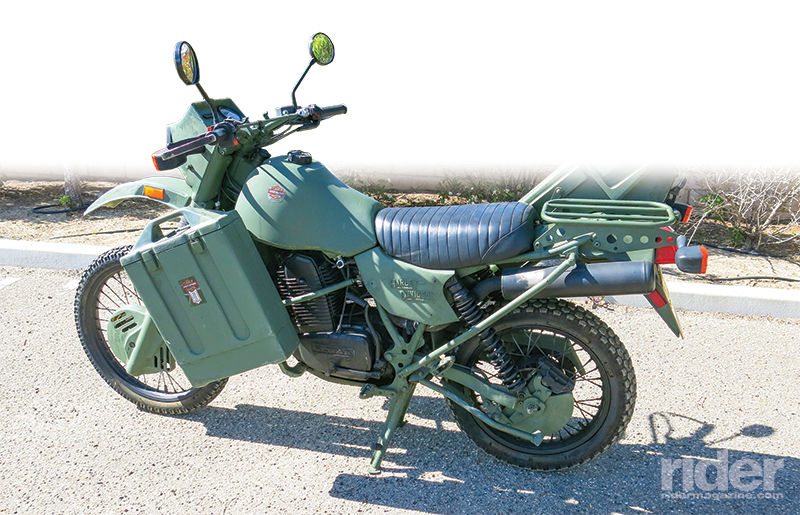
An unusual bike for the Harley brand, but this was back in its heyday when the Milwaukee company was booming and expanding in every direction. Over in Europe, the NATO countries had asked for a motorcycle to be used by the military, and the MT500 and MT350 were the result. These were rugged, rudimentary, dual-purpose motorcycles powered by Austrian-made Rotax engines in an Italian SWM frame, and put together with pieces from half-a-dozen members of the European Union. Armstrong-CCM Motorcycles in England built a number of these for use by troops in the 1982 Falklands War, and in 1987 sold the design and production rights to Harley-Davidson.
Apparently Harley thought it would be patriotic to produce this NATO-approved motorbike in the U.S., and since the company had recently gone public and its coffers were bulging, it could well afford this minor expenditure—though the figure that was paid to Armstrong appears to be top secret. At the Pennsylvania factory, a separate production line was set up after R&D spent a couple of years improving the 350 version, adding disc brakes and an electric starter, though the left-side kickstarter was maintained. Electrifying the 500 would have required major frame modifications, so that model was never produced.
Since this was essentially a European bike assembled in the United States, Harley did not issue much publicity about it, although HARLEY-DAVIDSON was writ large on both side covers. To enhance its American-made aspect, Harley did buy considerable stock in the Canadian Bombardier company, which had bought Rotax.
The single-cylinder Rotax engine (349cc, with a bore of 79.5mm, stroke 70.4mm) had been around for a number of years, sporting a belt-driven OHC and four valves, with the MT version having a compression ratio of 9:1 and a constant-velocity carburetor. This carb was a sealed unit, with no adjustments possible, not even the idle mixture. A paper air filter kept out the worst of the dirt and dust. A well-protected header pipe wrapped around the cylinder and then went on to a muffler on the left side.
Leaded or unleaded gasoline was fine, with 87 octane recommended. Sparking the plug was a CDI ignition, with a flywheel generator at the end of the crankshaft putting out 190 watts. Harley sensibly felt that the electric leg would be an improvement—easily added on to the 350 and using a 12-volt, 14-amp/hour battery. Power, rated at 30 horses at 8,000 rpm and 28 lb-ft of torque at 6,500 rpm, went through primary gears to a wet, multi-plate clutch (noted for a bit of stickiness), and a five-speed, pressure lubricated transmission. First gear was very low indeed, at a ratio of 1:2.9, good for climbing 60-degree slopes. Second gear (1:2.0) was often used when starting off. Final drive was a 520 O-ring chain.
The Rotax was a dry-sump engine, with 0.85 gallon of oil being held in the box-sectioned backbone of the frame. The engine was used as a stressed member, with an appropriately strong steel skid plate. The swingarm had needle roller bearings that were greaseable. Both sidestand and centerstand were provided.
The steering head had tapered roller bearings supporting a Marzocchi fork, leading to Akront alloy wheel rims with Grimeca disc brakes, one on each wheel. Brakes were identical front and rear, with nine-inch discs and two-piston calipers—plus round covers for the discs, which probably helped a bit in the mud. At the back, Öhlins shock absorbers were used. The front wheel was 21 inches, the rear, 18 inches, using tube-type tires. The rear wheel could be easily removed for repairs, leaving the chain drive and brake in place.
On top of all this was a 3.4-gallon gas tank, good for upwards of 150 miles depending on how rambunctious the throttle user was. The intended use was to go relatively slowly, but the thirsty top speed was around 75 mph. An old-fashioned ON/OFF/RES tap was used to access the gasoline. Above the headlight were the ignition switch, idiot lights and a speedometer reading to a realistic 70 mph. This was intended as a solo bike, with a longish, comfortable saddle, but passenger pegs were included for use in an “emergency situation.” The seat was nigh on 35 inches from the ground. Middling high bars were wide enough to give good leverage in the rough stuff, and the pegs were easy to stand up on. A heavy-duty plastic fender over the front wheel was mounted high enough that it would never get blocked with gumbo mud.
Dry weight was said to be 358 pounds, with a gross allowable weight of 800 pounds. And the carrying capacity? A large plastic gun case at the right rear would carry the rider’s rifle, and two large plastic pannier bags were mounted at the front, effectively protecting the rider’s knees. Curious thing about the panniers was that the lids could be locked, but the panniers themselves could not be locked to the bike. And the luggage rack was said to be strong enough that a helicopter could come overhead, put a hook through the rack, and fly away.
Here was the ideal dual-purpose bike, virtually indestructible, with a (figuratively speaking) bulletproof engine and reasonable seating. And since the finish was a combat-ready olive drab, one did not have to worry about keeping the paint shiny and the chrome polished.
A 100-page Military Motorcycle Operator’s Manual accompanied the bike, along with an 18-piece toolkit and a patch kit for inner tubes. Harley did enter into a “seven-year same build standard confirmation” agreement, producing the MTs from 1993 to 2000. And then they vanished! With no accessible data on how many were built or where they went. It is doubtful any ended up with U.S. armed forces.
PS: When Chris is not out riding his MT, it is on display at the Santa Maria, California, Harley dealership.

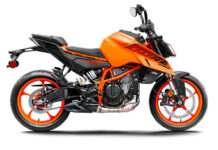
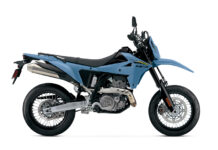
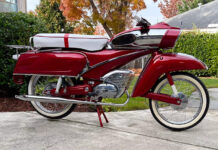
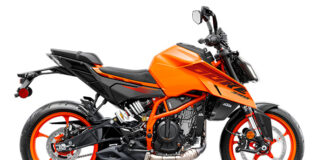
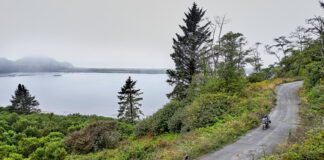
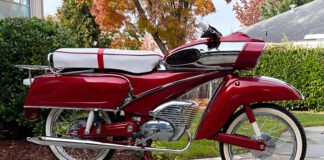

I’ve just bought one of these n I’m absolutely over the moon. This is a bike I’ve wanted just because of its absolute mean coolness. It’s a go anywhere carry jerry cans full of fuel round the world bike for me. I love it. Ive got a ninja n a vn 800 bobber which are cool but this gir me is my all season go anywhere bike n I’m super proud to be the owner of my mt350. Words cannot describe how happy I am to have bought this bike
Hello Out There,
I have a MT 350 that I need more technical details of than is given in the manual.My local test station want extra thing like exhaust gas emisssions and noise dBs and so on.Can anyone OutThere help please ?
Thank you,
John.
Check with David at Bull Pen cycles
Thank you.All is well.My German neighbour helped me with my questions.John.
I live in Laconia, New Hampshire. And I am trying to find anybody selling the MT 350E Harley Davidson dirtbike. It says in your article the years made were from 1993 to 2000. I actually parachuted into Panama in 1989 with one. Our special forces Units were equipped with a couple of of them. Are there any out there on the market?